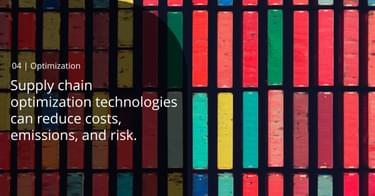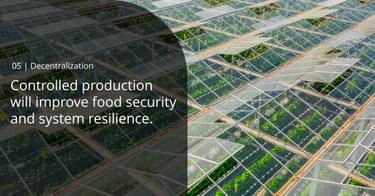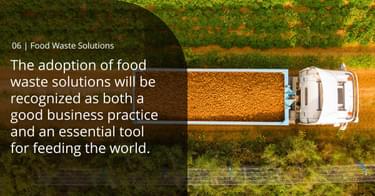
Reflections on 2023 Food & Agriculture Supply Chain Trends



This is the second installment of a series looking back on our report, “Trends Shaping the Future of Food in 2023.” Read Part 1 of this series, “Reflections on 2023 AgTech Trends,” and Part 3, “Reflections on 2023 Food Tech Trends.”
In March of 2023, we published a white paper entitled “Trends Shaping the Future of Food in 2023.” Almost a year later, we explore the year’s events that influenced the evolution of each trend and our view on its momentum going into the new year. In our last piece, we reflected on how our agtech trends fared in 2023. This article explores how our 2023 food and agriculture supply chain trends held up.

In 2023, we said, “Increased data collection across the supply chain, paired with advances in AI and ML, are enabling optimization solutions that will substantially lessen the environmental externalities of transportation while creating efficiencies and cost savings.”
2023 was a breakout year for generative AI. By October, less than a year after its launch, ChatGPT had about 1.7 billion monthly active users. A McKinsey survey from April found that one-third of survey respondents say their organizations use generative AI in at least one business function. AI is transforming almost every sector, and supply chain optimization stands to benefit substantially. The integration of advanced data collection methods, artificial intelligence, and machine learning are enabling increasingly powerful optimization solutions that significantly minimize the environmental impact of transportation while simultaneously fostering operational efficiencies and cost savings. For example, S2G portfolio company SWARM Engineering announced the launch of AVA, the first Agrifood Virtual AI Advisor, based on OpenAI, Microsoft Azure, and SWARM technology, to enable agrifood businesses to overcome supply chain challenges and realize substantial cost savings.
In the maritime sector, recent challenges in port supply chains have prompted a push for both product and process optimization strategies. 2023 saw the alternative fuel movement, sustainable aviation, and the exploration of new fuels gain traction. In addition, new regulations on maritime shipping illuminated a greater need for supply chain efficiencies and data-driven methods for ocean voyage optimization. Hapag-Lloyd’s first LNG dual fuel ultra-large containership entered service, and unprecedented numbers of additional LNG tankers are being ordered. In May, the EU Emissions Trading System (ETS) was extended to include shipping in 2024. Under the new law, carbon pricing in the EU ETS is determined based on vessels rather than cargo, and companies will have to submit allowances for 40% of their verified emissions. On the fuel efficiency side, S2G portfolio company Sofar Ocean combines publicly available weather data with data gathered by its global network of buoys. Sofar’s first product helps companies find the fastest route based on weather and ocean current conditions (essentially Google Maps for maritime shipping) to reduce a vessel’s greenhouse gas emissions and save costs on fuel consumption.

In 2023, we said, “Stabilization in the face of geopolitical issues, extreme weather events, and pest and disease outbreaks is becoming increasingly essential for resilient food systems. Decentralized systems that create redundancies and enable production in areas previously inhospitable to food production will increase supply chain resilience and food security across the globe.”
We are still seeing demand for and investment in decentralized food system solutions, but we have also seen some growing pains for controlled environment agriculture (CEA), land-based aquaculture, and cellular protein. With CEA, there is growing interest on the demand side driven by supply surety concerns from fresh produce retailers due to increased weather variability, food security concerns, and global food chain disruptions. ReFarm, a consortium in the United Arab Emirates, signed an agreement with FoodTech Valley to build a circular closed-loop GigaFarm to boost the country’s food security and decarbonize its food industry. S2G portfolio company IGS will provide the infrastructure for the farm, which will grow 2 billion plants a year, replacing 1 percent of the country’s fresh produce imports. But on the supply side, CEA operators are struggling to meet cost efficiency and scale. Greenhouses and vertical farms have seen labor and input costs increase and higher interest rates impact capex investments, making it harder to operate profitably. Companies with strong fundamentals will remain, but much of the industry has seen substantial consolidation activity.
With land-based aquaculture, the technology is promising, but the industry is still assessing what enabling technologies will be required to improve efficiencies and confer profitability. It will take a few more years and some trial and error, but we are seeing investment flowing in that direction, and several exciting projects are in the works to support the sector’s scaling capacity. For example, S2G portfolio company ReelData, which leverages AI to provide customized data and automation to land-based aquaculture farmers, closed an $8 million Series A round, and Iceland-based Laxey raised €42 million to build out its land-based salmon farming facility. Once the land-based aquaculture code gets cracked, we believe it will unlock any country’s, state’s, or region’s ability to produce high-quality and highly efficient protein from a resource use and capital standpoint.

In 2023, we said, “There is an ever-increasing interest in food waste solutions among public markets and later-stage businesses, especially with the recognition that mitigating food waste is an important climate solution. Even before increasing yields and using new land, if we focused on eliminating food waste, we’d be able to keep up with growing food demand for the foreseeable future.”
We believe food waste is still low-hanging fruit for companies looking to demonstrate their commitment to sustainable and responsible business practices. Between November 2021 and 2022, food prices rose 10.6 percent and an additional 2.9 percent by November 2023, bolstering the economic incentive for food waste solutions for both consumers and the grocery sector, which has profit margins of 1 – 3 percent. Legislative efforts in the US further underscore the growing recognition of food waste as a critical issue. Senators and representatives have introduced bills like the Zero Food Waste Act and the COMPOST Act, which would create a grant program to provide funding for projects that prevent or divert food waste or gather data about food waste practices. The bipartisan NO TIME TO Waste Act would further support research and new technologies that work towards reducing food loss and waste by 50 percent by 2030.
Due to the clear need and accessibility of the issue, food waste solutions abound across the food supply chain. In July, S2G portfolio company Flashfood and SpartanNash announced they have diverted 1 million pounds of food waste and have saved shoppers $1.9 million on groceries since partnering in 2020, helping the grocery chain meet key elements of its ESG strategy, while increasing profitability. Divert, a company working with grocery retailers to process surplus food into renewable gas, received a $1 billion funding agreement to help build and deploy its technology. S2G portfolio company Mill passed the toothbrush test, meaning 99 percent of users are interacting with the bin more than twice a day, and also received a unanimous vote from the FDA approving a definition for “dried recovery household food” as an ingredient in animal feed – the first company to achieve this – which will unlock a new higher-use regulatory pathway for food waste.
These sectors are still trending upward, with greater recognition of the need for resilient supply chains from Covid and the increase in unpredictable geopolitical and climate events. Adopting supply chain optimization, food waste reduction, and maritime decarbonization solutions, which are win-wins for the environment and companies’ bottom lines, is increasingly a no-brainer.
Check out our next article for our reflections on 2023 food tech trends.
Listen to more insights about the food and ag sector in the S2G Podcast.




